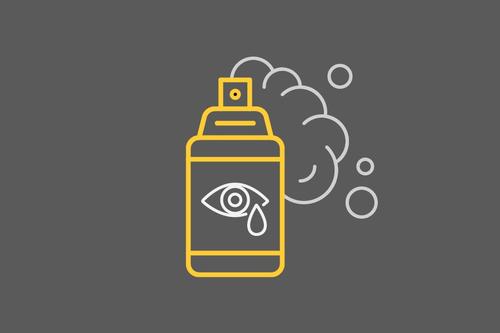
The U.S. military can’t use tear gas against wartime enemies, but police are free to deploy it routinely against protesters, including peaceful ones, at home.
Last year five U of M neuroscience graduate students—Jennifer L. Brown, Roman Tyshynsky, Timothy Monko, Carlee Toddes, and Carey E. Lyons—decided to investigate this practice. Besides their devotion to promoting health through their research, they were spurred by events that occurred in, essentially, their back yard.
“It’s shocking enough to watch this unfold on a screen, but it’s entirely different to witness the community trauma, the anger, the grief firsthand,” they explain. … “It wasn’t until last summer that we saw armored National Guard vehicles drive down the streets of our own city during the protests against the killing of George Floyd.
“Shocked by the sheer volume of tear gas and the indiscriminate threat to peaceful protests during a respiratory-disease pandemic, we used our research training to investigate this form of ‘less lethal’ crowd control.”
In scouring historical texts and the research literature, the team concluded that “the reassuring description of these weapons covers up a much more alarming story.”
The researchers discuss their findings in a peer-reviewed article in the Journal of Science Policy & Governance and an opinion piece in Scientific American.
Hidden history
Tear gas was first used in 1914 by French soldiers to flush German soldiers from their trenches. The U of M researchers learned that its greatest American champion was Gen. Amos Fries, head of the Army’s Chemical Warfare Service, which was founded during the war. After the 1925 ratification of the Geneva Protocol banning tear gas use in war (it was also banned in 1993 by the Chemical Weapons Convention), Fries was left with a stockpile of chemical weapons and nowhere to use them.
So the general “decided to make use of this cache by selling it to private security forces and police departments across the country, while maintaining close ties to one of the tear gas manufacturers,” the researchers write. “Police throughout the country started using these chemicals, swayed by propaganda campaigns encouraged by Fries and his team of lawyers, marketers and scientists. It quickly became the ‘humane’ alternative for police and private security forces to use for crowd dispersal.”
The researchers also found that rhetoric in favor of tear gas use was “suffused with white supremacist language” that “likely contributed to its aggressive use against civil rights protestors in the 1960s.” They describe the history of its use by law enforcement as “rife with corruption and racist intent.”
Wide use, little regulation
Searching for the federal agency that regulates tear gas manufacture and use, the team was surprised to find neither the EPA, FDA, CDC, nor Bureau of Alcohol, Tobacco, Firearms and Explosives claimed oversight.
The team looked at a commonly used form of tear gas called CS. They discovered that while the EPA sets “acute exposure guideline levels for airborne chemicals,” there is no concentration of CS gas that can be considered less than level 2, described as “irreversible or other serious, long-lasting adverse health effects or an impaired ability to escape.”
They also report that the privately owned manufacturers of tear gas face little regulatory scrutiny or public accountability.
“This is nothing new,” they say. “Since the beginning of the popularization of tear gas use for law enforcement in the United States, private entities have influenced both national and local policy.”
Sketchy research
The Geneva Protocol allows the use of tear gas on civilians if its effects “disappear after a short time,” the researchers report. But after the tearing and respiratory effects like burning and shortness of breath have eased, they found little solid research on outcomes for victims of gassing.
Yet a CDC fact sheet lists several long-lasting effects of long-term or high-dose exposure: blindness, glaucoma, immediate death from chemical burns to throat or lungs; and respiratory failure, possibly resulting in death.
“The level of [tear gas] exposure required to elicit symptoms, toxic effects, and lethal outcomes has not been well established, especially among diverse populations,” the researchers say. And they point out that establishing such parameters by exposing volunteers would be fraught with ethical barriers.
Past research also indicates that tear gas is toxic to plants and animals, can spread readily through soil and water, and may persist for long periods.
Given all this, the researchers suggest policy options to replace tear gas use. They cite protocols that prescribe de-escalation tactics, as well as instilling in officers the recognition that their job is to protect the right to free speech and assembly, protect people before property, and engage with protesters before, during, and after demonstrations.
A new day dawning?
The U of M team has met with legislators and representatives of news media. And now, an investigation of the health effects of tear gas has been opened in the U.S. House of Representatives.
While she and her colleagues claim no direct credit for this development, Jennifer Brown doesn’t rule out all influence by herself and her colleagues.
“I do hope that we contributed to the awareness of this issue, and that the increase in awareness and discussions in the media helped push this topic into a House panel,” she says. “It's a work in progress, and change will be slow, but I at least am hopeful.”
- Categories:
- Health
- Human rights
- Medical
- Social policy





